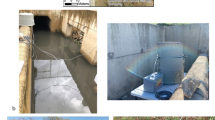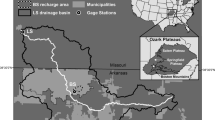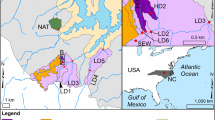Abstract
Because of their architecture, karst aquifers are susceptible to contamination by fecal-derived pathogens. Previous studies have examined the behavior of bacterial indicators such as total coliforms (TC) and fecal coliforms (FC) in karst aquifers, but simple techniques for discriminating between human and non-human inputs are still needed. This study examines concentrations of TC, FC, atypical colonies (AC, which grow on the same media as TC), male-specific coliphage virus (MSP, an indicator of human feces), and nitrate at two springs in the Inner Bluegrass region of Kentucky (USA). Blue Hole Spring primarily drains the city of Versailles, whereas spring SP-2 drains pasture. Baseflow was monitored, usually biweekly, from December 2002 to March 2004, while storm flow was monitored in September 2003 and March 2004. At each spring, bacterial concentrations were highest in storm flow and lowest in “normal” baseflow (for which 72-h antecedent precipitation was negligible). Concentrations in baseflow tended to be highest during late spring and summer and lowest during autumn and winter. FC concentrations exceeded regulatory (contact) standards in storm-flow samples. For both storm flow and baseflow, AC concentrations were greater than TC, which in turn were greater than FC. Median AC and TC concentrations were greater in baseflow at Blue Hole than at SP-2. MSP was detected in most samples from Blue Hole but never at SP-2. The AC/TC ratio was typically <15 except for normal baseflow samples at Blue Hole, which is probably impacted by leakage from sanitary sewers, as suggested by MSP and nitrate results. Mobilization of sessile bacteria appears to reduce the AC/TC ratio during storm flow. Consequently, this ratio shows promise as a screening tool to identify sewage inputs in karst groundwater basins under baseflow conditions.







Similar content being viewed by others
References
Aley T (1984) Groundwater tracing in water pollution studies. Nat Speleol Soc Bull 46:17–20
APHA (American Public Health Association) (1998) Standard methods for the examination of water and wastewater. APHA, Washington, DC
Boyer DG, Kuczynska E (2003) Storm and seasonal distributions of fecal coliforms and Cryptosporidium in a spring. J Am Water Resour Assoc 39:1449–1456
Brion GM, Mao HH (2000) Use of total coliform test for watershed monitoring with respects to atypicals. J Environ Eng 126:175–181
Brion GM, Mao HH, Lingireddy S (2000) New approach to use of total coliform test for watershed management. Water Sci Technol 42:65–69
Brion GM, Meschke JS, Sobsey MD (2002) F-specific RNA coliphages: occurrence, types, and survival in natural waters. Water Res 36:2419–2425
Currens JC, Paylor RL, Ray JA (2002) Mapped karst ground-water basins in the Lexington 30 × 60 minute quadrangle. Kentucky Geological Survey Map and Chart 10. Series XII. University of Kentucky, Lexington
Davis RK, Hamilton S, Brahana JV (2005) Escherichia coli survival in mantled karst springs and streams, northwest Arkansas Ozarks, USA. J Am Water Resour Assoc 41:1279–1287
Droppo IG, Liss SN, Williams D, Nelson T, Jaskot C, Trapp B (2009) Dynamic existence of waterborne pathogens within river sediment compartments. Implications for water quality regulatory affairs. Environ Sci Technol 43:1737–1743
Dussart-Baptista L, Massei N, Dupont J-P, Jouenne T (2003) Transfer of bacteria-contaminated particles in a karst aquifer: evolution of contaminated materials from a sinkhole to a spring. J Hydrol 284:285–295
Edwards DR, Coyne MS, Daniel TC, Vendrell PF, Murdoch JF, Moore PA (1997) Indicator bacteria concentrations of two northern Arkansas streams in relation to flow and season. Trans ASAE 40:103–109
Field KG, Samadpour M (2007) Fecal source tracking, the indicator paradigm, and managing water quality. Water Res 41:3517–3538
Ford DC, Williams PW (1989) Karst geomorphology and hydrology. Unwin Hyman, London
Gunn J, Tranter J, Perkins J, Hunter C (1997) Sanitary bacterial dynamics in a mixed karst aquifer. In: Leibundgut C, Gunn J, Dassargues A (eds) Karst hydrology. Int Assoc Hydrol Sci Publ 247. IAHS Press, Wallingford, pp 61–70
John DE, Rose JB (2005) Review of factors affecting microbial survival in groundwater. Environ Sci Technol 39:7345–7356
Keagy DM, Dinger JS, Fogle AW, Sendlein LVA (1993) Interim report on the occurrence of pesticides, nitrate, and bacteria on groundwater quality in a karst terrain—the Inner Blue Grass region, Woodford County, Kentucky. Kentucky Geological Survey Open-File Report OF-93-04. University of Kentucky, Lexington
Kentucky Division of Water (2007) Kentucky administrative regulations, surface water standards. http://www.lrc.ky.gov/kar/401/010/031.htm. Accessed April 2009
Madigan MT, Martinko JM, Parker J (2003) Brock biology of microorganisms. Prentice Hall, Upper Saddle River
Mahler BJ, Personné J-C, Lods GF, Drogue C (2000) Transport of free and particulate-associated bacteria in karst. J Hydrol 238:179–193
Marshall D, Brahana JV, Davis RK (1998) Resuspension of viable sediment-bound enteric pathogens in shallow karst aquifers. In: Brahana JV, Eckstein Y, Ongley LK, Schneider R, Moore JE (eds) Gambling with groundwater—physical, chemical, and biological aspects of aquifer-stream relations. Proc Joint Meet XXVIII Congr Int Assoc Hydrogeol, Annu Meet Am Inst Hydrol. American Institute of Hydrology, St. Paul, pp 179–186
Nieman J, Brion GM (2003) Novel bacterial ratio for predicting fecal age. Water Sci Technol 47:45–49
Pasquarell GC, Boyer DG (1995) Agricultural impacts on bacterial water quality in karst groundwater. J Environ Qual 24:959–969
Plummer JD, Long SC (2009) Identifying sources of surface water pollution: a toolbox approach. J AWWA 101:75–88
Pronk M, Goldscheider N, Zopfi J (2007) Particle-size distribution as indicator for fecal bacteria contamination of drinking water from karst springs. Environ Sci Technol 41:8400–8405
Quinlan JF (1989) Ground-water monitoring in karst terranes: recommended protocols and implicit assumptions. Rep EPA/600/X-89/050. US Environmental Protection Agency, Las Vegas
Rantz SE (1982) Measurement and computation of streamflow, vol 1. Measurement of stage and discharge. US Geological Survey Water-Supply Paper 2175. US Government Printing Office, Washington, DC
Reed TM (2006) Suspended sediment and pathogen transport in two Inner Bluegrass karst ground-water basins, Woodford County, Kentucky. MS thesis, University of Kentucky. http://lib.uky.edu/ETD/ukygeol2006t00499/REED06.pdf. Accessed April 2009
Reed TM, McFarland JT, Fryar AE, Fogle AW, Taraba JL (2010) Sediment discharges during storm flow from proximal urban and rural karst springs, central Kentucky, USA. J Hydrol 383:280–290
Rosner BA (2006) Fundamentals of biostatistics. Thomas Higher Education, Belmont
Ryan M, Meiman J (1996) An examination of short-term variations in water quality at a karst spring in Kentucky. Ground Water 34:23–30
Sercu B, van de Werfhorst LC, Murray J, Holden PA (2009) Storm drains are sources of human fecal pollution during dry weather in three urban Southern California watersheds. Environ Sci Technol 43:293–298
Simon KS, Gibert J, Petitot P, Laurent R (2001) Spatial and temporal patterns of bacterial density and metabolic activity in a karst aquifer. Arch Hydrobiol 151:67–82
Thrailkill J, Spangler LE, Hopper WM Jr, McCann MR, Troester JW, Gouzie DR (1982) Groundwater in the Inner Bluegrass karst region, Kentucky. Water Resour Res Inst Res Rep 136. University of Kentucky, Lexington
University of Kentucky Agricultural Weather Center (2008) Climatology data. http://wwwagwx.ca.uky.edu/climdata.html. Accessed March 2008
USEPA (US Environmental Protection Agency) (2001) EPA method 1602: Male-specific (F+) and somatic coliphage in water by single agar layer (SAL) procedure. Rep EPA/821/R-01/029. Office of Water, USEPA, Washington, DC
US Census Bureau (2008) Census 2000 data for the state of Kentucky. http://www.census.gov/census2000/states/ky.html. Accessed April 2008
Ward JW, Reed TM, Fryar AE, Brion GM (2009) Using the AC/TC ratio to evaluate fecal inputs in a karst groundwater basin. Environ Eng Geosci 15:57–65
White WB (1988) Geomorphology and hydrology of karst terrains. Oxford University Press, New York
Acknowledgments
The research described herein was funded by the UK College of Agriculture through the Senate Bill 271 program and by the Kentucky NSF-EPSCoR program. Paul and Jerry Campbell (City of Versailles) and the UK ARC provided access to the springs. Todd Aseltyne and Todd McFarland assisted with field work; Alex Fogle (Kentucky Geological Survey) and Joseph Taraba (UK Biosystems and Agricultural Engineering) provided discharge data for SP-2; and Tricia Coakley (ERTL), Bob King (ERTL), and Jim Crutchfield (UK Plant and Soil Sciences) assisted with laboratory analyses. Larry McKay and two anonymous reviewers provided constructive comments on a prior version of the manuscript.
Author information
Authors and Affiliations
Corresponding author
Rights and permissions
About this article
Cite this article
Reed, T.M., Fryar, A.E., Brion, G.M. et al. Differences in pathogen indicators between proximal urban and rural karst springs, Central Kentucky, USA. Environ Earth Sci 64, 47–55 (2011). https://doi.org/10.1007/s12665-010-0816-8
Received:
Accepted:
Published:
Issue Date:
DOI: https://doi.org/10.1007/s12665-010-0816-8




